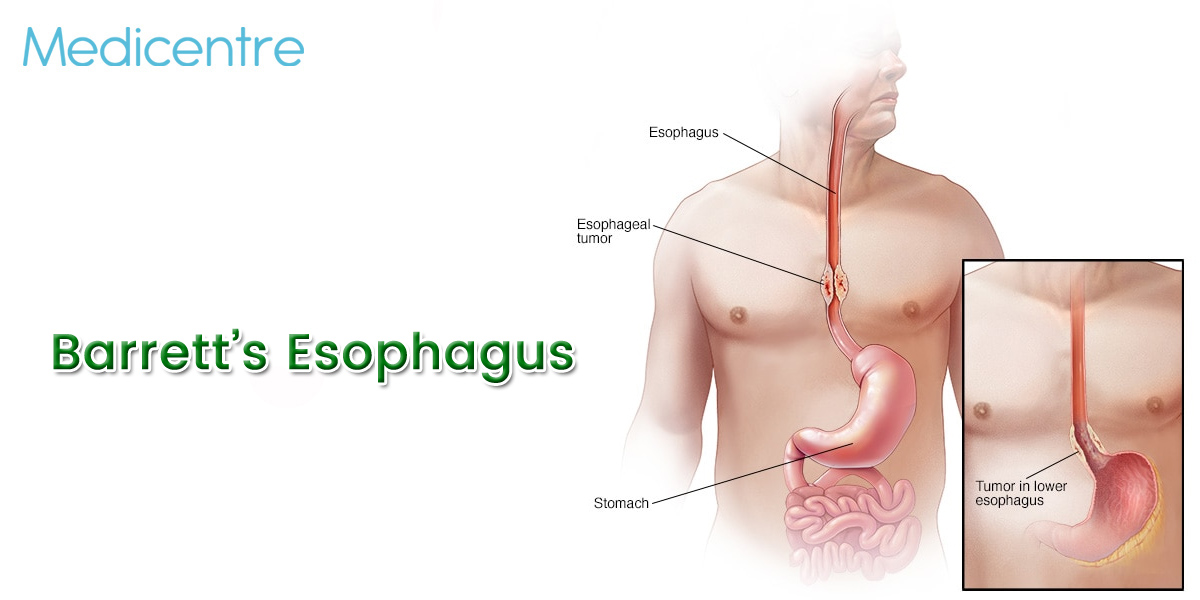Barrett’s Esophagus
Barrett’s Esophagus is the medical condition where the tissue present in your tube connecting the stomach and mouth is replaced by the similar tissue like intestinal lining. People who are suffering from long term gastroesophageal reflux disease or GERD are likely to develop Barrett’s Esophagus. GERD is the chronic condition where regurgitation of acid occurs in stomach in your lower esophagus. Only selected number of people with GERD would develop Barrett’s Esophagus.
Because of Barrett’s Esophagus, patients may also have the increasing risk of esophageal cancer. The risk is low, but it is suggested that you must have regular checking of the precancerous cells so that early treatment can be started to prevent the cancer from developing.

WWhat are the Symptoms of Barrett’s Esophagus?
There are no specific symptoms of Barrett’s Esophagus. The symptoms that are developed in patients with Barrett’s Esophagus are due to GERD and this may include:
- Difficulty in swallowing foods
- Heartburn issue very often
- Chest pain which is rare
What are the Causes of Barrett’s Esophagus?
It is still not aware why Barrett’s Esophagus is caused. It is believed that people with long term GERD issues usually get victimized of Barrett’s Esophagus. In the condition of GERD, the stomach acids or contents flush back to esophagus and this damage the esophagus tissues. When the esophagus attempts to heal itself, a change in the cells and tissues occur like the type of tissues which are found during Barrett’s Esophagus.
Most of the patients who have been diagnosed with Barrett’s Esophagus have never complained about acid reflux or heartburn issues. The exact cause of Barrett’s Esophagus is still not found.
Risk Factors & Complications of Barrett’s Esophagus
There are certain factors which increase the risk of developing Barrett’s Esophagus and this includes:
- Aging factors – Older adults are more likely to develop Barrett’s Esophagus
- Acid Reflux and Chronic Heartburn – People who have been diagnosed with GERD for more than 5-6 years are the higher risk of developing Barrett’s Esophagus. The risk may increase if you are above 30 years.
- Being a Man and White in Tone – Unlike women, men are more likely to develop Barrett’s Esophagus and having white skin tone also increases the risk of such developing such condition
- Overweight people, especially fatty cells around the abdomen, increases the risk of developing Barrett’s Esophagus
- Smoking also considered to be an underlying cause of Barrett’s Esophagus
Diagnosis of Barrett’s Esophagus
Doctors usually recommend the patients to undergo a test called endoscopy if they suspect the presence of Barrett’s Esophagus. In the procedure, the doctors will insert a lighted tube with camera down to your throat so as to check the symptoms of changing esophagus tissues. The tissues that appears to be glossy and pale are considered normal and when it seems to be velvety or red, then it is confirmed that you are having Barrett’s Esophagus.
Small tissue sample is also extracted for biopsy where the tissue is examined to identify the degree of changes in tissues. The tissues are examined in labs and the pathologists find out the degree of dysplasia in the esophagus cells.
Treatment Plans for Barrett’s Esophagus
The treatment plan for Barrett’s Esophagus depends on the degree of dysplasia that is found in the esophagus cells and your health condition.
For no dysplasia or low grade dysplasia your doctors may prescribe with treatment plan for curing the GERD. Periodic endoscopy is also recommended so as to monitor the cells present in your esophagus. With lifestyle changes and medications the signs and symptoms can be improved. Surgery is also performed to make the sphincter tighter which controls the flow of the stomach acid.
For high grade dysplasia doctors may prescribe a variety of treatment which includes:
- Endoscopic Resection
- Radiofrequency Ablation
- Cryotherapy
- Photodynamic therapy
Surgery is performed to remove the damaged part of esophagus and attach the remaining part to stomach